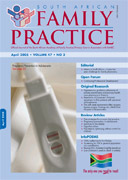Relevance of Schneider’s first-rank symptoms in Zulu patients with paranoid schizophrenia.
Abstract
Background: The aim of this study was to examine the prevalence of Schneider’s first-rank symptoms (FRS) in Zulu patients diagnosed with paranoid schizophrenia and to ascertain the diagnostic and prognostic significance of Schneider’s FRS in this group. Methods: This descriptive study was done on 75 psychiatric Zulu in- and outpatients diagnosed with paranoid schizophrenia. A questionnaire was completed and included sociodemographic data, Schneider’s FRS and a functional assessment. Results: Fifty-three percent of the patients heard voices at some or other time. Most patients (90.7%) confirmed having experienced at least one of the five related symptoms of thought disturbances and 80% of the patients confirmed the presence of passivity phenomena. Most patients (87%) indicated that they had presented at least one type of primary delusion, at the time of the interview. Regarding functional assessment, some (12%) patients were still entirely productive (“no problems), 28% rated “mild problems, 45% “moderate problems and 15% “severe problems. With regard to social functioning, 8% of the patients scored “no problems, 25% “mild problems, 50% “moderate problems and 17% “severe problems. Conclusions: The prevalence of Schneider’s FRS in these patients is 100%, with a 95% confidence interval [95.2%; 100%]. Even though extremely sensitive for paranoid schizophrenia, the specificity of Schneider’s FRS merits further study. (SA Fam Pract 2005;47(3): 55-60)
Published
2005-04-01
Section
Original Research
By submitting manuscripts to SAFP, authors of original articles are assigning copyright to the South African Academy of Family Physicians. Copyright of review articles are assigned to the Publisher, Medpharm Publications (Pty) Ltd, unless otherwise specified. Authors may use their own work after publication without written permission, provided they acknowledge the original source. Individuals and academic institutions may freely copy and distribute articles published in SAFP for educational and research purposes without obtaining permission.

